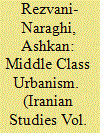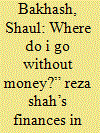|
|
|
Sort Order |
|
|
|
Items / Page
|
|
|
|
|
|
|
| Srl | Item |
| 1 |
ID:
157837


|
|
|
|
|
| Summary/Abstract |
One of the most exceptional among the world renowned historical treasures is the repository of valuables of the olden shahs of Persia found in the Jewels Museum in Tehran. The outstanding jewel among those kept there is the diamond called Daryā-ye Nur, weighing about 182 carats. The history of this stone, according to the literature on the subject, starts in seventeenth century India, in the city of Golconda. Analysis of primary sources, however, allows for the supposition that this stone may have a longer history.
|
|
|
|
|
|
|
|
|
|
|
|
|
|
|
|
| 2 |
ID:
157834


|
|
|
|
|
| Summary/Abstract |
This article uses narratives of the death of Cyrus the Great as a test case in order to examine the use of propaganda in the Achaemenid empire. By comparing the accounts found in Herodotus, Ctesias, and Xenophon, it is shown that these Greek historians have captured propagandistic messages created in the courts of contemporary Achaemenid kings. While the Greek works were very much the product of their authors’ literary imagination, nevertheless they preserved substantial evidence about the role of propaganda during the Achaemenid period.
|
|
|
|
|
|
|
|
|
|
|
|
|
|
|
|
| 3 |
ID:
157838


|
|
|
|
|
| Summary/Abstract |
Most of the available literature on Tehran between the two world wars deals with the morphological transformation of the city and the role of the Pahlavi state in accomplishing massive urban projects. In contrast, this article focuses on the reciprocal relationship between the sociality and spatiality of the city. It demonstrates how the consolidation of the discourse of modernity resulted in the development of social and political desires for the production of new forms of social life and spaces. The article argues that the formation of the modern middle class and its alignment with the Pahlavi state’s reform projects contributed to a twofold process: first, the decline of the traditional forms of social life and spaces and, second, the production and prevalence of alternative forms. This process resulted in the establishment of social dichotomies with vast spatial manifestations and polarized the city both socially and spatially.
|
|
|
|
|
|
|
|
|
|
|
|
|
|
|
|
| 4 |
ID:
157840


|
|
|
|
|
| Summary/Abstract |
Focusing on black women Qadam-Kheyr and Sorur in Mahshid Amirshahi’s novel Dadeh Qadam-Kheyr (1999), this article examines literary representations of the African-Iranian presence, and provides a critique of race and slavery in twentieth-century Iran. In light of the history of the Iranian slave trade until 1928, and the reconstruction of race and gender identities along Eurocentric lines of nationalism in Iran, the novel under scrutiny is a dynamic site of struggle between an “Iranian” literary discourse and its “non-Persian” Others. The “aesthetics of alterity” at the heart of the text is, therefore, the interplay between the repressed title-character Qadam-Kheyr and the resilient minor character Sorur, each registering Amirshahi’s artistic intervention into a forgotten corner of Iranian history.
|
|
|
|
|
|
|
|
|
|
|
|
|
|
|
|
| 5 |
ID:
157835


|
|
|
|
|
| Summary/Abstract |
This paper examines the anecdotes of ʿAttār’s Mosibat-nāmeh as temporal phenomena from the perspective of a reader moving progressively through the text; it is argued that that these anecdotes do not function primarily as carriers of dogmatic information, but as dynamic rhetorical performances designed to prod their audiences into recommitting to a pious mode of life. First, the article shows how the poem’s frame-tale influences a reader’s experience of the embedded anecdotes by encouraging a sequential mode of consumption and contextualizing the work’s pedagogical aims. Next, it is demonstrated that these anecdotes are bound together through formulae and lexical triggers, producing a paratactic structure reminiscent of oral homiletics. Individual anecdotes aim to unsettle readers’ ossified religious understandings, and together they offer a flexible set of heuristics for pious living. Finally, it is argued that ʿAttār’s intended readers were likely familiar with the mystical principles that underlie his poems; he therefore did not use narratives to provide completely new teachings, but rather to persuade his audience to more fully embody those pious principles to which they were already committed.
|
|
|
|
|
|
|
|
|
|
|
|
|
|
|
|
| 6 |
ID:
157836


|
|
|
|
|
| Summary/Abstract |
This article presents excerpts from two near-contemporary works of popular prose from the medieval Near East: the Persian Dārāb-nāmeh and the Arabic Sīrat Banī Hilāl. In each, birds or birdlike characters (the sīmorgh and the crow, respectively) that share in having had theriomorphic, mythic significance in regional pre-Islamic traditions dispense premonitory wisdom to Muslim characters. Comparing these passages, the article contends that the characterization of these birds brokers a pietistic shift in symbolism between the pre-Islamic and Islamic context, while still maintaining the birds’ mystical significance and sustaining the trope of birds as winged, heaven-sent messengers. This modified association between birds and divine ministry is not only prominent in these two texts, but also in the Qurʾān and varied bestiaries, poetry, and belletristic works that comprise these texts’ cultural network.
|
|
|
|
|
|
|
|
|
|
|
|
|
|
|
|
| 7 |
ID:
157839


|
|
|
|
|
| Summary/Abstract |
When Reza Shah died in exile in Johannesburg, South Africa, in July 1944, he left in his account at Barclays Bank a deposit of £110,000, a considerable amount of money. Yet when he went into exile only three years earlier, Reza Shah feared he would be hard-pressed for money, if not left altogether destitute—and with good reason. He left Iran with a “horde” of progeny, family members and retainers. Before departing, he had ceded all his enormous wealth in cash and property to his son and successor. He did not remain destitute for long. His son, the new shah, continued to send him money, and for a while the British paid for a major part of his upkeep. Yet his money anxieties did not cease. This article describes and follows the winding trail of Reza Shah’s finances in exile.
|
|
|
|
|
|
|
|
|
|
|
|
|
|
|
|
|
|
|
|
|